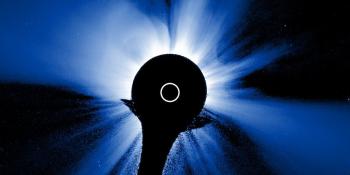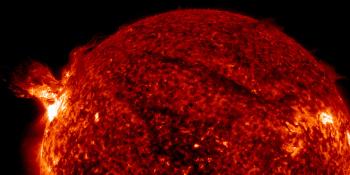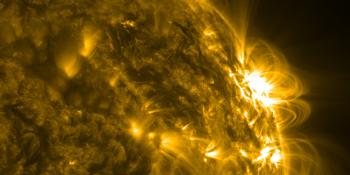Bespreking van het voorspelde ruimteweer
Datum verslag: 2025 Dec 20 0030 UTC
Dit rapport werd door opgemaakt door het Space Weather Prediction Center - NOAA en verwerkt door Poollicht.be
Zonneactiviteit
Samenvatting afgelopen 24h
Solar activity briefly reached moderate levels due to an impulsive M1.0 at 19/1558 UTC that originated from a region just beyond the southeast limb. Regions 4308 (N08, L=136) and 4310 (N03, L=177) decayed to plage, while new spots were observed near N23E44 but remain unnumbered at this time given their age and lack of growth since emergence. The remaining active regions were either stable or showing signs of decay. No Earth-directed CMEs were observed in available coronagraph imagery.Voorspelling
Solar activity is expected to be at low levels with occasional C-class flares through 22 Dec.Energetische deeltjes
Samenvatting afgelopen 24h
The greater than 2 MeV electron flux reached high levels with a peak flux of 3,240 pfu at 19/1810 UTC. The greater than 10 MeV proton flux was steady at background levels.Voorspelling
The greater than 2 MeV electron flux is expected to reach high levels through 21 Dec before decreasing to normal to moderate levels on 22 Dec with the arrival of a corotating interaction region ahead of faster solar wind. The greater than 10 MeV proton flux is expected to persist at background levels through 22 Dec given the lack of complex, energetic active regions currently inhabiting the visible solar disk.Zonnewind
Samenvatting afgelopen 24h
The solar wind environment reflected waning negative polarity CH HSS influences. Total field decreased from 5 nT to 2-4 nT while the Bz component was benign at rougly +/- 5 nT. Solar wind speeds peaked near 670 km/s before gradually declining to about 500 km/s. Phi was predominantly negative, but began undergoing oscillations into the positive sector late in the period.Voorspelling
The solar wind environment is expected to remain mildly enhanced over 20 Dec as negative polarity CH HSS influences diminish. Background conditions are then expected to prevail on 21 Dec. An enhanced regime is anticipated to return on 22 Dec due to recurrent, positive polarity CH HSS influences.Geospace
Samenvatting afgelopen 24h
Geomagnetic field activity was at quiet levels.Voorspelling
Geomagnetic field activity is expected to be at quiet levels with a chance for isolated periods on 20 Dec as CH HSS effects continue to diminish with quiet conditions then continuing on into 21 Dec. G1 (Minor) geomagnetic storming is likely on 22 Dec due to recurrent, positive polarity CH HSS effects.Laatste nieuws
Laatste forumberichten
Noorderlicht kans mogelijkheid 6-14 dec 2025 14STEVE, een nog onbegrepen fenomeen 1Noorderlichtkans 11-12 november 2025 21Noorderlicht kans 18 juni 2025 3Noorderlicht 2 juni 2025 3
Meer forumberichtenSteun Poollicht.be!
Veel mensen komen naar Poollicht.be om de zonneactiviteit te volgen of om het poollicht te zien, maar met meer bezoekers komen er hogere kosten bij om de servers online te houden. Als je Poollicht.be leuk vindt en het project wilt steunen, kun je kiezen voor een abonnement op een advertentievrije website of een donatie overwegen. Met jouw hulp kunnen we Poollicht. be online houden!
Ruimteweer feitjes
| Laatste X-klasse uitbarsting | 08/12/2025 | X1.1 |
| Laatste M-klasse uitbarsting | 19/12/2025 | M1.0 |
| Laatste geomagnetische storm | 12/12/2025 | Kp5 (G1) |
| Zonnevlekkenloze dagen | |
|---|---|
| Laatste zonnevlekkenloze dag | 08/06/2022 |
| Maandelijks gemiddeld zonnevlekkengetal | |
|---|---|
| november 2025 | 91.8 -22.8 |
| december 2025 | 125.7 +33.9 |
| Afgelopen 30 dagen | 111.4 +22.1 |





